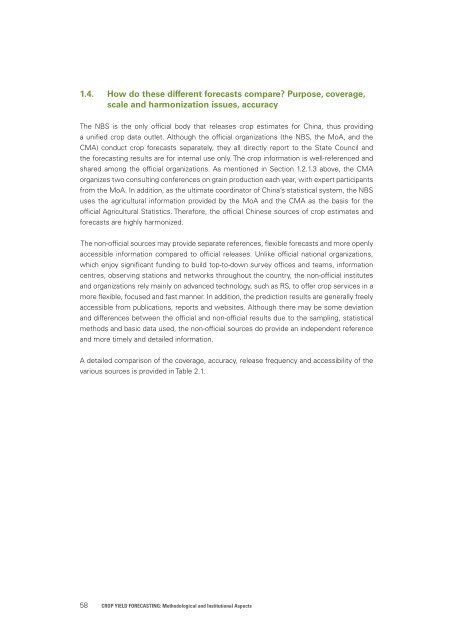Crop Yield Forecasting
1qKZxmS
1qKZxmS
Create successful ePaper yourself
Turn your PDF publications into a flip-book with our unique Google optimized e-Paper software.
1.4. How do these different forecasts compare? Purpose, coverage,<br />
scale and harmonization issues, accuracy<br />
The NBS is the only official body that releases crop estimates for China, thus providing<br />
a unified crop data outlet. Although the official organizations (the NBS, the MoA, and the<br />
CMA) conduct crop forecasts separately, they all directly report to the State Council and<br />
the forecasting results are for internal use only. The crop information is well-referenced and<br />
shared among the official organizations. As mentioned in Section 1.2.1.3 above, the CMA<br />
organizes two consulting conferences on grain production each year, with expert participants<br />
from the MoA. In addition, as the ultimate coordinator of China’s statistical system, the NBS<br />
uses the agricultural information provided by the MoA and the CMA as the basis for the<br />
official Agricultural Statistics. Therefore, the official Chinese sources of crop estimates and<br />
forecasts are highly harmonized.<br />
The non-official sources may provide separate references, flexible forecasts and more openly<br />
accessible information compared to official releases. Unlike official national organizations,<br />
which enjoy significant funding to build top-to-down survey offices and teams, information<br />
centres, observing stations and networks throughout the country, the non-official institutes<br />
and organizations rely mainly on advanced technology, such as RS, to offer crop services in a<br />
more flexible, focused and fast manner. In addition, the prediction results are generally freely<br />
accessible from publications, reports and websites. Although there may be some deviation<br />
and differences between the official and non-official results due to the sampling, statistical<br />
methods and basic data used, the non-official sources do provide an independent reference<br />
and more timely and detailed information.<br />
A detailed comparison of the coverage, accuracy, release frequency and accessibility of the<br />
various sources is provided in Table 2.1.<br />
58<br />
<strong>Crop</strong> <strong>Yield</strong> <strong>Forecasting</strong>: Methodological and Institutional Aspects


